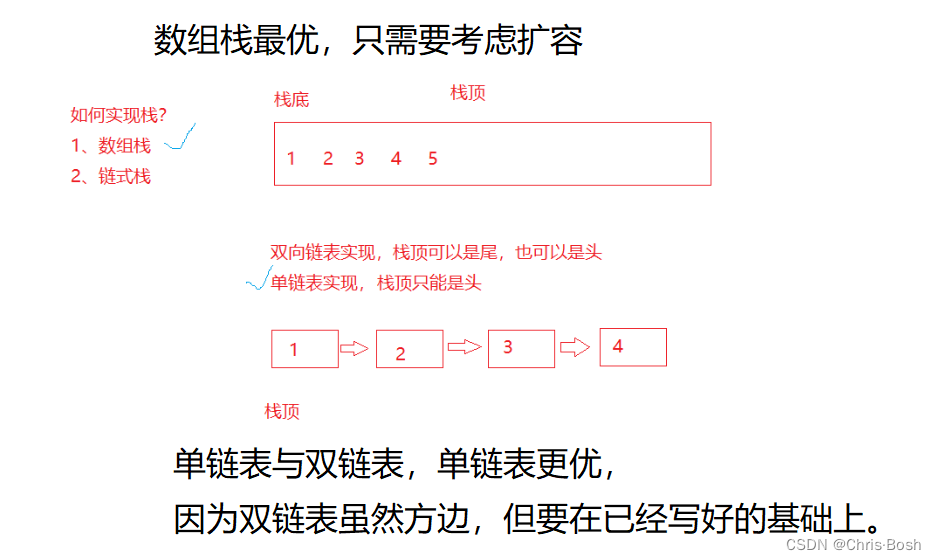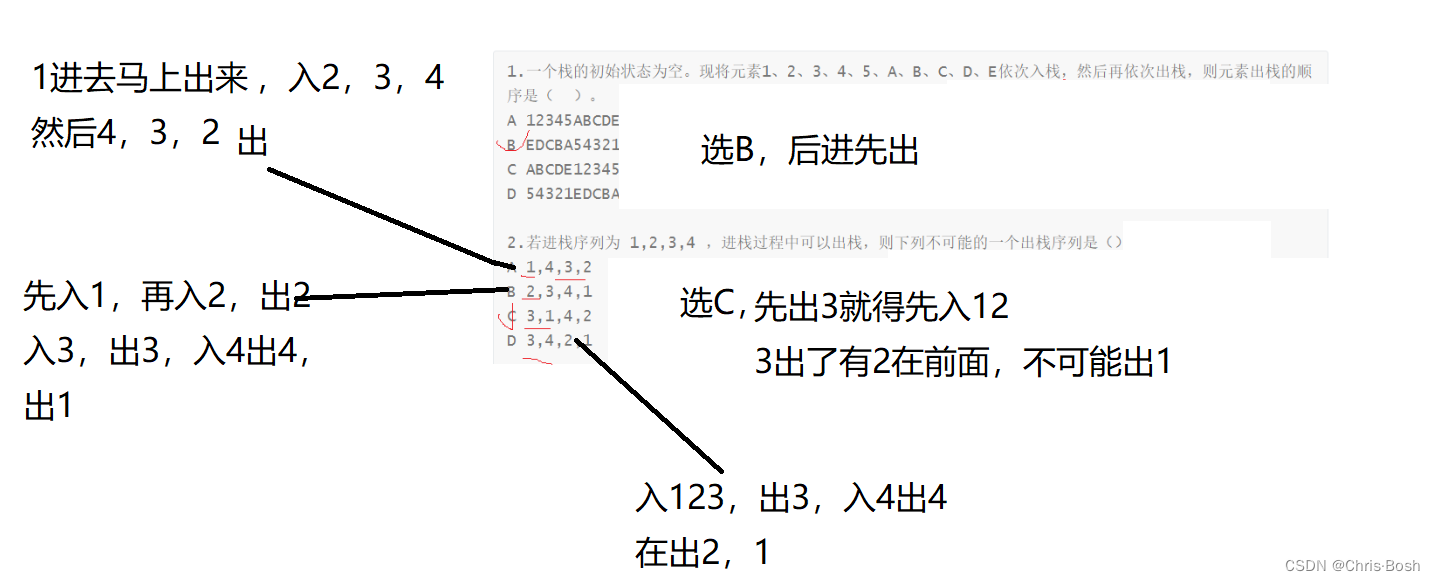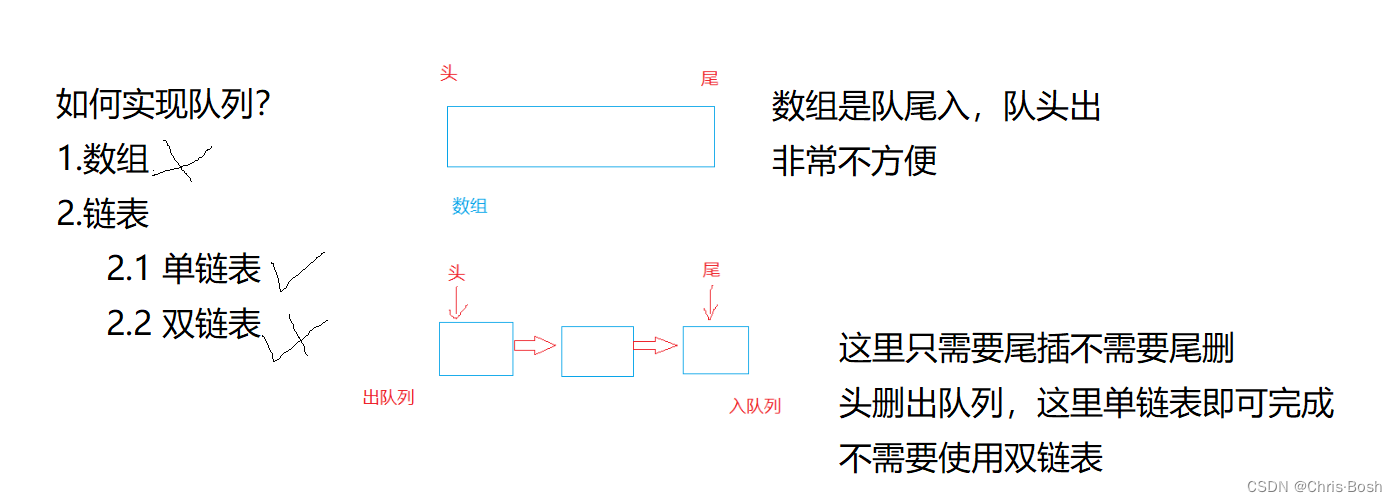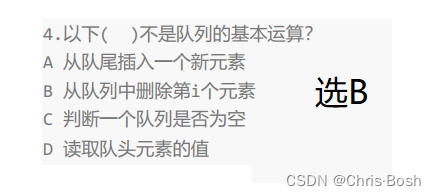前言
本篇主要介绍栈和队列的相关知识,练习以及代码实现。
代码主要展示部分功能的实现。完整代码在gitee上查看。
链接: 栈和队列的完整代码实现
1.栈
1.1 栈的概念及结构
①栈:一种特殊的线性表,其只允许在固定的一端进行插入和删除元素操作。进行数据插入和删除操作的一端称为栈顶,另一端称为栈底。栈中的数据元素遵守后进先出LIFO(Last In First Out)的原则。
②压栈:栈的插入操作叫做进栈/压栈/入栈,入数据在栈顶。
③出栈:栈的删除操作叫做出栈。出数据也在栈顶

1.2 栈的实现
栈的实现有两种方式

1.3 栈的代码实现
1.3.1 栈的初始化
void STInit(ST* pst)
{
assert(pst);
pst->a = NULL;
pst->capacity = 0;
pst->top = 0;//top是什么?0?
}

所以有两种设计方案:

我们采用top=0的方案!
1.3.2 栈顶插入
void STPush(ST* pst, STDataType x)
{
assert(pst);
//扩容
if (pst->top == pst->capacity)
{
int newcapacity = pst->capacity == 0 ? 4 : pst->capacity * 2;
STDataType* tmp = (STDataType*)realloc(pst->a, sizeof(STDataType) * newcapacity);
if (tmp == NULL)
{
perror("realloc fail");
return;
}
pst->a = tmp;
pst->capacity = newcapacity;
}
//插入
pst->a[pst->top] = x;
pst->top++;
}
1.3.3 栈顶删除
void STPop(ST* pst)
{
assert(pst);
// top为0不能减减
assert(pst->top > 0);
pst->top--;
}
1.3.4 返回栈顶数据
STDataType STTop(ST* pst)
{
assert(pst);
// 不为空
assert(pst->top > 0);
return pst->a[pst->top - 1];//表达式应该是(pst->top) - 1,表示栈顶元素的前一个元素
}
1.3.5 判断栈是否为空
bool STEmpty(ST* pst)
{
assert(pst);
if (pst->top == 0)
return true;
else
return false;
}
1.3.6 获取栈中有效元素个数
int STSize(ST* pst)
{
assert(pst);
return pst->top;
}
1.3.7 销毁栈
void STDestroy(ST* pst)
{
assert(pst);
free(pst->a);
pst->a = NULL;
pst->top = pst->capacity = 0;
}
1.3.8 主函数测试
int main()
{
ST s;
STInit(&s);
STPush(&s, 1);
STPush(&s, 2);
STPush(&s, 3);
printf("%d ", STTop(&s));
STPop(&s);
printf("%d ", STTop(&s));
STPop(&s);
STPush(&s, 4);
STPush(&s, 5);
// 一 对 多
// 入栈顺序 -- 出栈顺序
while (!STEmpty(&s))
{
printf("%d ", STTop(&s));
STPop(&s);
}
printf("\n");
return 0;
}
后进先出是相对的,具体要看代码
入栈数据只有一种,出栈顺序可以是多种。
1.4 栈的练习题

2.队列
2.1 队列的概念及结构
队列:只允许在一端进行插入数据操作,在另一端进行删除数据操作的特殊线性表,队列具有先进先出FIFO(First In First Out)
入队列:进行插入操作的一端称为队尾
出队列:进行删除操作的一端称为队头。


2.2 队列的实现

2.3 队列的代码实现
2.3.1 队列的初始化
void QueueInit(Queue* pq)
{
assert(pq);
pq->phead = pq->ptail = NULL;
pq->size = 0;
}
2.3.2 队列的尾插
void QueuePush(Queue* pq, QDataType x)
{
assert(pq);
QNode* newnode = (QNode*)malloc(sizeof(QNode));
if (newnode == NULL)
{
perror("malloc fail");
return;
}
newnode->val = x;
newnode->next = NULL;
if (pq->ptail == NULL)
{
pq->ptail = pq->phead = newnode;
}
else
{
pq->ptail->next = newnode;
pq->ptail = newnode;
}
pq->size++;
}
2.3.3 队列的头删
void QueuePop(Queue* pq)
{
assert(pq);
assert(pq->phead);
QNode* del = pq->phead;
pq->phead = pq->phead->next;
free(del);
del = NULL;
if (pq->phead == NULL)
pq->ptail = NULL;
pq->size--;
}

2.3.4 获取队列头部元素
QDataType QueueFront(Queue* pq)
{
assert(pq);
assert(pq->phead);
return pq->phead->val;
}
2.3.5 获取队列尾部元素
QDataType QueueBack(Queue* pq)
{
assert(pq);
assert(pq->ptail);
return pq->ptail->val;
}
2.3.6 检测队列是否为空
bool QueueEmpty(Queue* pq)
{
assert(pq);
return pq->phead == NULL;
}
2.3.7 获取队列中有效元素个数
int QueueSize(Queue* pq)
{
assert(pq);
return pq->size;
}
2.3.8 摧毁
void QueueDestroy(Queue* pq)
{
assert(pq);
QNode* cur = pq->phead;
while (cur)
{
QNode* next = cur->next;
free(cur);
cur = next;
}
pq->phead = pq->ptail = NULL;
pq->size = 0;
}
2.3.9 主函数测试
int main()
{
Queue q;
QueueInit(&q);
QueuePush(&q, 1);
QueuePush(&q, 2);
QueuePush(&q, 3);
printf("%d ", QueueFront(&q));
QueuePop(&q);
printf("%d ", QueueFront(&q));
QueuePop(&q);
QueuePush(&q, 4);
QueuePush(&q, 5);
while (!QueueEmpty(&q))
{
printf("%d ", QueueFront(&q));
QueuePop(&q);
}
QueueDestroy(&q);
return 0;
}
2.4 队列的练习题
